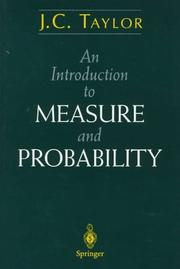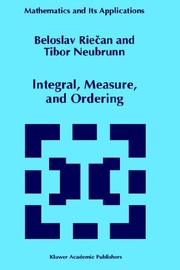| Listing 1 - 2 of 2 |
Sort by
|

ISBN: 1461206596 0387948309 9780387948300 Year: 1997 Publisher: New York Springer
Abstract | Keywords | Export | Availability | Bookmark
 Loading...
Loading...Choose an application
- Reference Manager
- EndNote
- RefWorks (Direct export to RefWorks)
Assuming only calculus and linear algebra, this book introduces the reader in a technically complete way to measure theory and probability, discrete martingales, and weak convergence. It is self- contained and rigorous with a tutorial approach that leads the reader to develop basic skills in analysis and probability. While the original goal was to bring discrete martingale theory to a wide readership, it has been extended so that the book also covers the basic topics of measure theory as well as giving an introduction to the Central Limit Theory and weak convergence. Students of pure mathematics and statistics can expect to acquire a sound introduction to basic measure theory and probability. A reader with a background in finance, business, or engineering should be able to acquire a technical understanding of discrete martingales in the equivalent of one semester. J. C. Taylor is a Professor in the Department of Mathematics and Statistics at McGill University in Montreal. He is the author of numerous articles on potential theory, both probabilistic and analytic, and is particularly interested in the potential theory of symmetric spaces.
Measure theory. --- Probabilities. --- Stochastic processes --- Measure theory. Mathematical integration --- Measure theory --- Probabilities --- Mesure, Théorie de la --- Probabilités --- Functions of real variables. --- Probability Theory and Stochastic Processes. --- Real Functions. --- Real variables --- Functions of complex variables --- Probability --- Statistical inference --- Combinations --- Mathematics --- Chance --- Least squares --- Mathematical statistics --- Risk --- Research. --- Lebesgue measure --- Measurable sets --- Measure of a set --- Algebraic topology --- Integrals, Generalized --- Measure algebras --- Rings (Algebra)

ISBN: 0792345665 9048148553 9401589194 Year: 1997 Publisher: Boston (Mass.) : Kluwer academic,
Abstract | Keywords | Export | Availability | Bookmark
 Loading...
Loading...Choose an application
- Reference Manager
- EndNote
- RefWorks (Direct export to RefWorks)
The present book is a monograph including some recent results of mea sure and integration theory. It concerns three main ideas. The first idea deals with some ordering structures such as Riesz spaces and lattice or dered groups, and their relation to measure and integration theory. The second is the idea of fuzzy sets, quite new in general, and in measure theory particularly. The third area concerns some models of quantum mechanical systems. We study mainly models based on fuzzy set theory. Some recent results are systematically presented along with our suggestions for further development. The first chapter has an introductory character, where we present basic definitions and notations. Simultaneously, this chapter can be regarded as an elementary introduction to fuzzy set theory. Chapter 2 contains an original approach to the convergence of sequences of measurable functions. While the notion of a null set can be determined uniquely, the notion of a set of "small" measure has a fuzzy character. It is interesting that the notion of fuzzy set and the notion of a set of small measure (described mathematically by so-called small systems) were introduced independently at almost the same time. Although the axiomatic systems in both theories mentioned are quite different, we show that the notion of a small system can be considered from the point of view of fuzzy sets.
Measure theory. Mathematical integration --- Fuzzy sets. --- Integrals, Generalized. --- Measure theory. --- Mathematical logic. --- Probabilities. --- Algebra. --- Ordered algebraic structures. --- Applied mathematics. --- Engineering mathematics. --- Measure and Integration. --- Mathematical Logic and Foundations. --- Probability Theory and Stochastic Processes. --- Order, Lattices, Ordered Algebraic Structures. --- Applications of Mathematics. --- Engineering --- Engineering analysis --- Mathematical analysis --- Algebraic structures, Ordered --- Structures, Ordered algebraic --- Algebra --- Mathematics --- Probability --- Statistical inference --- Combinations --- Chance --- Least squares --- Mathematical statistics --- Risk --- Algebra of logic --- Logic, Universal --- Mathematical logic --- Symbolic and mathematical logic --- Symbolic logic --- Algebra, Abstract --- Metamathematics --- Set theory --- Syllogism --- Lebesgue measure --- Measurable sets --- Measure of a set --- Algebraic topology --- Integrals, Generalized --- Measure algebras --- Rings (Algebra) --- Calculus, Integral --- Sets, Fuzzy --- Fuzzy mathematics
| Listing 1 - 2 of 2 |
Sort by
|

 Search
Search Feedback
Feedback About UniCat
About UniCat  Help
Help News
News